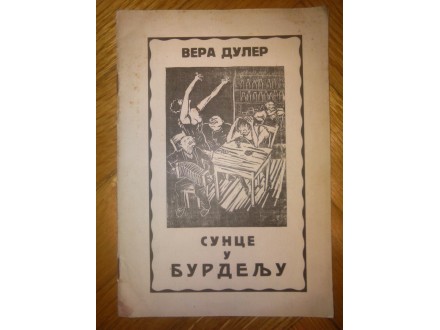Sunce u burdelju-Duler-1931-LINOREZ Mefert-AVANGARDA
Stara cena |
3.499 din |
|
| Cena: | ||
| Želi ovaj predmet: | 2 |
| Stanje: | Polovan bez oštećenja |
| Garancija: | Ne |
| Isporuka: | Pošta CC paket (Pošta) Post Express Lično preuzimanje |
| Plaćanje: | Tekući račun (pre slanja)
Lično |
| Grad: |
Beograd-Vračar, Beograd-Vračar |
ISBN: Ostalo
Godina izdanja: 1900 - 1949.
Autor: Domaći
Tematika: Književnost
Kulturno dobro: Predmet koji prodajem nije kulturno dobro ili ovlašćena institucija odbija pravo preče kupovine
Jezik: Srpski
Vera Duler - Sunce u burdelju
Jagodina, 1931.
Mek povez, 20 strana.
Drvorez na naslovnoj strani Karl Mefert, Berlin.
EKSTREMNO RETKO!
Joseph Carl Meffert (26 March 1903 in Koblenz, Germany – 27 December 1988 in Sirnach, Switzerland), better known by his nom de plume Clément Moreau, was a politically and socially conscious graphic designer and artist. His best-known work is the wordless novel Night over Germany.
Personal life
Josef Carl Meffert was born out-of-wedlock in Koblenz, Germany on 26 March 1903. After a difficult childhood, he spent 1914 to 1918 in two hospitals in Westphalia.
In 1927, he moved to Berlin, where he came into contact with Käthe Kollwitz, Emil Orlik, Heinrich Vogeler, Otto Nagel and John Heartfield, among others. Thanks in part to their encouragement, Meffert produced his first graphic works, as well as book and magazine illustrations for the workers` press. A passionate relationship developed with Sonja Marchlewska, the wife of Heinrich Vogeler, who had referred the then drug addict to Käthe Kollwitz.[1]
He went into exile in Argentina in 1935, where he worked at the Argentinisches Tageblatt newspaper.
Carl Meffert and his sister were born out of wedlock. When their mother died giving birth to a third child, the eleven-year-old Carl was sent to a state care institution where the young inmates had both to attend school and work. From a young age, Meffert learnt to flee threatening situations, and ran away from the home several times. Flight and urgency became the dominant themes of his life. After several unsuccessful attempts to flee the care home, he finally succeeded in 1919. Meffert joined the Spartacus League and was arrested on political grounds one year later. He spent several years in prison, after which he moved to Berlin in the late 1920s to work as a commercial artist. There, he met, among others, Käthe Kollwitz, Erich Mühsam, George Grosz and John Heartfield. During his time in Berlin, he began to explore political and biographical themes in his art. His work from this period includes the linocut series Erwerbslose Jugend [Unemployed Youth] (1928) and Fürsorgeerziehung [Corrective Training] (1928/29).
In the 1930s, Meffert lived principally in Switzerland. After the burning of the Reichstag in February 1933, he returned to Berlin for a final visit. He narrowly escaped arrest by the Gestapo and managed to flee back to Switzerland. From then on he lived as an illegal immigrant in Switzerland and took the name Clément Moreau. To avoid being arrested by the Swiss immigration police, he fled to Argentina in 1935. There he created the cycle Nacht über Deutschland [Night over Germany] in 1937/38. Even after the end of the Second World War, Moreau’s life as a fugitive continued: when the military junta took power in Argentina in 1962, he visited Switzerland and never returned.
tags: avangarda, socijalna umetnost, socijalizam, nemacki socijalizam, vajmarska republika, ekspresionizam, nemacki ekspresionizam, nadrealizam, nadrealisti, marko ristic, koca popovic, levica, george grosz, nolit, bihalji...
Predmet: 76314089







